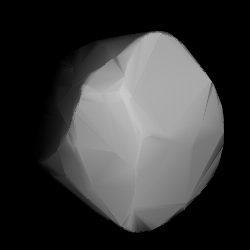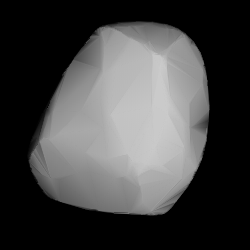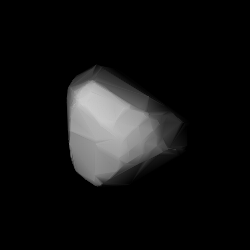Related Research Articles

4015 Wilson–Harrington is an active asteroid known both as comet 107P/Wilson–Harrington and as asteroid 4015 Wilson–Harrington. It passed 0.4 AU (60 million km) from Earth on 20 July 2022 and then passed perihelion on 24 August 2022. It seldom gets brighter than apparent magnitude 16. It will return to perihelion on 25 November 2026.
719 Albert, provisional designation 1911 MT, is a stony asteroid, approximately 2.5 kilometers in diameter, classified as a near-Earth object of the Amor group of asteroids. It was discovered by Austrian astronomer Johann Palisa at the Vienna Observatory on 3 October 1911, and subsequently a lost minor planet for 89 years. The asteroid was named in memory of Albert Salomon Anselm von Rothschild, an Austrian philanthropist and banker. Albert was the second Amor asteroid discovered, the first being 433 Eros.

154 Bertha is a main-belt asteroid. It was discovered by the French brothers Paul Henry and Prosper Henry on 4 November 1875, but the credit for the discovery was given to Prosper. It is probably named after Berthe Martin-Flammarion, sister of the astronomer Camille Flammarion.

177 Irma is a fairly large and dark main belt asteroid. It was discovered by the French brothers Paul Henry and Prosper Henry on November 5, 1877. Paul was credited for this discovery. The meaning of the name Irma is unknown.

200 Dynamene is a large dark main-belt asteroid that was discovered by German-American astronomer Christian Heinrich Friedrich Peters on July 27, 1879, in Clinton, New York. The name derives from Dynamene, one of the fifty Nereids in Greek mythology. Based upon its spectrum, 200 Dynamene is classified as a C-type asteroid, indicating that it probably has a primitive composition similar to the carbonaceous chondrite meteorites. The spectra of the asteroid displays evidence of aqueous alteration.
447 Valentine is a large Main belt asteroid.

450 Brigitta is a typical Main belt asteroid. It is a member of the Eos family.
473 Nolli is a rather small asteroid that may be in the Eunomia family. It was discovered by Max Wolf on February 13, 1901, but only observed for 1 month so it became a lost asteroid for many decades. It was recovered in 1987, 86 years after its discovery.
525 Adelaide is an S-type asteroid belonging to the Flora family in the Main Belt. It was discovered 21 October 1908 by Joel Hastings Metcalf.
610 Valeska is a minor planet, specifically an asteroid, orbiting primarily in the asteroid belt. Discovered in 1906 by Max Wolf. The origin of the name is unknown, but it may be related to the provisional designation 1906 VK. In Slavic origin, it also means Glorious ruler. Photometric observations provide a rotation period of 4.9047±0.0002 h with a brightness variation of 0.17±0.03 in magnitude.
649 Josefa is a minor planet, specifically an asteroid, orbiting primarily in the asteroid belt. Photometric observations provide a rotation period of 10.481±0.001 h with a brightness variation of 0.33±0.04 in magnitude.
652 Jubilatrix is a minor planet, specifically an asteroid orbiting in the asteroid belt. It was discovered on 4 November 1907 by Austrian astronomer Johann Palisa, and was named in honor of the 60th anniversary of the reign of Franz Joseph. The asteroid is orbiting at a distance of 2.55 AU with a period of 4.08 yr and an eccentricity of 0.127. It is a member of the Maria dynamic family. Photometric observations provide a rotation period of 2.6627±0.0001 h with a brightness variation of 0.27±0.03 in magnitude.
723 Hammonia is a minor planet orbiting the Sun. It was discovered in 1911 and is named after the city of Hamburg. Although the name alludes to Hamburg it was discovered in Vienna.
724 Hapag is a minor planet orbiting the Sun in the asteroid belt that was found by Austrian astronomer Johann Palisa in 1911 and named after the German shipping company Hamburg America Line. It was assigned a provisional name of 1911 NC, then became a lost asteroid until it was rediscovered in 1988 as 1988 VG2 by Tsutomu Hioki and N. Kawasato at Okutama, Japan.
727 Nipponia is a minor planet orbiting the Sun. It is a member of the Maria family of asteroids.
843 Nicolaia is a main-belt asteroid discovered by Danish astronomer H. Thiele on 30 September 1916. It was a lost asteroid for 65 years before being rediscovered by Astronomisches Rechen-Institut at Heidelberg in 1981. The asteroid is orbiting the Sun with a period of 3.44 years.
878 Mildred is a minor planet in the main belt orbiting the Sun. It is the lowest numbered, and thus the namesake, of the Mildred family of asteroids, a subgroup of the Nysa family. The Mildred subgroup, and by extension 878 Mildred itself, is thought to have been formed by a recent fragmentation event from a larger asteroid.
880 Herba is a minor planet orbiting the Sun that was discovered by German astronomer Max Wolf on 22 July 1917 in Heidelberg.

1537 Transylvania, provisional designation 1940 QA, is a carbonaceous asteroid and long-lost minor planet from the outer regions of the asteroid belt, approximately 17 kilometers in diameter. Discovered by Gyula Strommer in 1940, it was later named after region of Transylvania, where the discoverer was born.

A minor planet is "lost" when today's observers cannot find it, because its location is too uncertain to target observations. This happens if the orbital elements of a minor planet are not known accurately enough, typically because the observation arc for the object is too short, or too few observations were made before the object became unobservable.
References
- ↑ "452 Hamiltonia (A899 XB)". JPL Small-Body Database . NASA/Jet Propulsion Laboratory . Retrieved 19 September 2021.
- 1 2 (1537) Transylvania and (452) Hamiltonia Kristensen, L. K.; Gibson, J.; Shao, C.-Y.; Bowell, E.; Marsden, B. G. IAU Circ., 3595, 1 (1981). Edited by Marsden, B. G.
- ↑ Cowen, Ron (20 May 2000). "Astronomers Rediscover Long-Lost Asteroid". Vol. 157, no. 21. Science News. Archived from the original on 28 December 2012.